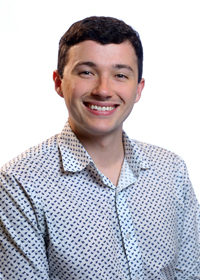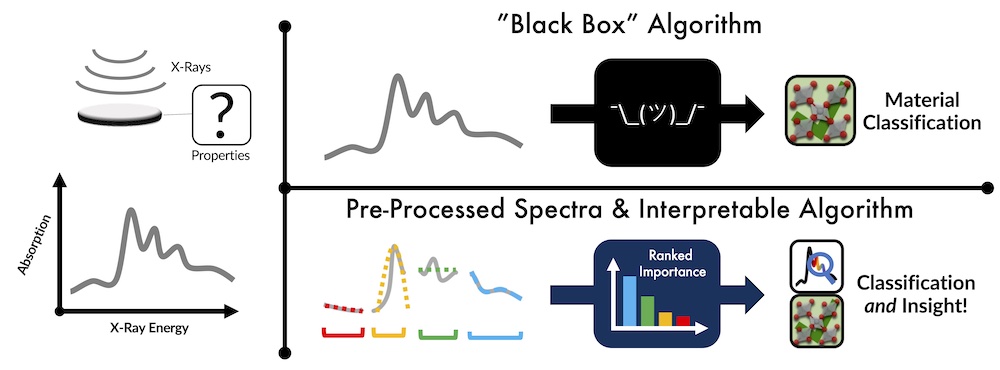
Steven Torrisi
Harvard University
When Steven Torrisi arrived at Lawrence Berkeley National Laboratory for his 2018 practicum, he knew he was interested in materials physics, but working with Kristin Persson and her Materials Project team changed his direction. Torrisi used the group’s high-performance computing methods to examine how atom-thin sheets of materials could harness light to break apart carbon dioxide. It led to a paper in the journal npj 2D Materials and Applications.
At the lab, the Department of Energy Computational Science Graduate Fellowship (DOE CSGF) recipient found he enjoyed working on a project with immediate applications and collaborating with industry researchers. He also was drawn to the team’s focus on developing well-written scientific code that researchers could share.
Once back at Harvard University, “I started working on projects that were more geared toward high-throughput studies and automation,” Torrisi says. He’s also helped develop other materials physics software packages.
Torrisi’s high school math teachers in New York’s Hudson Valley helped him recognize his talents, and he pored over physics and astronomy books by Richard Feynman, Carl Sagan and Neil deGrasse Tyson. As a junior, Torrisi saw a flyer in his school’s hallway about research opportunities at Roswell Park Cancer Institute in Buffalo, New York, and applied. He spent that summer studying how laser pulses could kill cancer cells and interacting with some of the clinic’s patients. It was a transformative experience, he says, helping him understand that “oh, wow, this stuff really matters.”
Torrisi majored in mathematics and physics at the University of Rochester and pursued research in subjects that ranged from plasma to optics. He planned to study quantum computing at Harvard before deciding he wanted to work on subjects with more immediate energy applications.

His Berkeley Lab practicum also sparked an interest in public-private research partnerships, and Torrisi returned to California for a summer 2019 internship at Toyota Research Institute (TRI), where he collaborated with DOE CSGF recipient Matthew Carbone on a machine-learning tool to analyze X-ray absorption spectroscopy (XAS) results.
“I've worked on a pretty dizzying array of different things over the last few years,” Torrisi says. “It’s been very helpful to dip into other ponds.” As a result, his graduate research has centered on using machine learning to study materials’ structure and function. In one project, he explored how a twist between sheets of graphene or molybdenum disulfide can change their optical and electronic properties.
Torrisi also has worked on catalyst design. Researchers in this field often must balance compounds’ ability to accelerate useful reactions against chemical stability. His work can help probe combinations of reactive metals, such as palladium, with more stable ones, such as silver, and their interactions with hydrogen, carbon monoxide and other gases. By understanding the molecular choreography at these surfaces, he says, researchers can propose more useful experiments to test these combinations in the lab. Working with Harvard and Stony Brook University partners, Torrisi also uses his XAS knowledge to study catalytically active nanoparticles.
Torrisi devotes significant time to teaching and mentoring. As an undergraduate he worked as an assistant for physics courses for six semesters. He’s a residential advisor in one of Harvard’s undergraduate houses, helping students improve their writing and navigate career choices. Torrisi also assists with the Women+ of Color Project @ Harvard, an initiative to increase the pipeline of women from underrepresented communities into science Ph.D. programs, particularly physics.
Torrisi plans to complete his degree in 2021 and is exploring career options in research – he’s particularly interested in Berkeley Lab and TRI – public service and science policy.
The fellowship’s independence and resources provided Torrisi a range of rewarding opportunities. “They shaped my research interests entirely,” he says. “A lot of the things that have been wonderful and exciting about my time in graduate school were born directly from the DOE CSGF.”
Image caption: Shining X-rays of different energies on a material (left) yields a characteristic absorption pattern: a spiked edge with wiggles in the post-edge region and occasional bumps in the pre-edge regions. Some previous research to match these spectra with material properties (top right) used black box algorithms, which solve the problem but are difficult to understand. Fitting simple curves to different spectrum segments (lower right) and applying an algorithm that determines different inputs’ significance enables material-property classification and can elucidate what parts of the spectra matter and how. Credit: Steven Torrisi.


